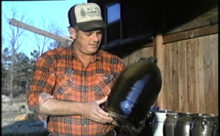The Southern Stoneware Pottery Tradition
When Jerry Brown makes his ware, he works within the southern stoneware pottery tradition. In the mid-19th century, folk potteries began to dwindle in the northern United States, replaced by factories that mass-produced pottery. Pottery production in the North was characterized by formal apprenticeships and the adoption of modern industrial methods. During the same period, folk potteries reached their peak in the South. These potteries were often operated by descendants of European potters (and sometimes their slaves) who brought the trade over from Europe. Follow the settlement patterns throughout the South and you will find the places where potters found clay and established their farms and potteries. Many potteries were located in the rural piedmont area? between the mountains and the coastal plain? sof the Carolinas, Georgia and Alabama. Typically, the potter farmed the land during the warm months and made pottery in the winter, employing his family or hired help form the community. Thus, the skills of the trade were carried on, both within the family and without.
Jerry Brown is one of only a handful of traditional potters still working in the United State. His roots in the southern stoneware tradition run deep. Brown is a direct-line seventh generation potter, and the Brown Pottery lineage may be as long as nine or ten generations. Browns migrated from Virginia to Georgia in the early 1800s, backtracked to the Carolinas, and passed through the Deep South on their way to Texas (where Jerry Brown?s great-great uncle, Taylor Brown, introduced alkaline glazing in the early 19th century). And where Browns settled, potteries appeared and the trade was sustained. Horace "Jug" Brown?s legacy was carried on by Alabama potter Norman Smith (1904-1990), a Chilton County potter who learned pottery making from Jug long before son Jerry took up the trade. Jerry Brown keeps the southern stoneware tradition alive as he passes his skills on to his own children. He digs his clay locally from the same clay pit used by the Rye family, a pottery family that was active in the area in the 19th century. He processes his clay in a mule-drawn pug mill and fires by wood or gas in an above-ground groundhog or tunnel kiln. He uses the commercial glazes adopted by most southern potters in the late 19th century, though he sometimes experiments with the traditional alkaline glaze formulas used by his ancestors
